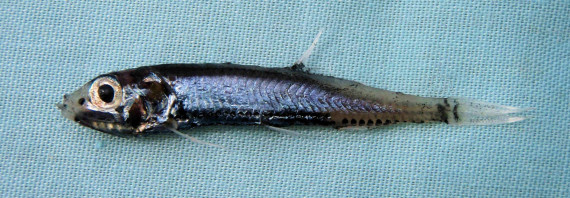Panama Lightfish, Vinciguerria lucetia
 Panama Lightfish, Vinciguerria lucetia. Fish collected off the beach at Point Palmilla, Baja California Sur, April 2009. Length: 4.0 cm (1.6 inches). Identification courtesy of Cindy Klepadio, Scripps Institute of Oceanography, La Jolla, California.
Panama Lightfish, Vinciguerria lucetia. Fish collected off the beach at Point Palmilla, Baja California Sur, April 2009. Length: 4.0 cm (1.6 inches). Identification courtesy of Cindy Klepadio, Scripps Institute of Oceanography, La Jolla, California.
 Panama Lightfish, Vinciguerria lucetia. Fish collected off the beach at Los Barriles, Baja California Sur, January 2018. Length: 4.1 cm (1.6 inches). Collection courtesy of Brad Murakami, Surrey, British Columbia, Canada.
Panama Lightfish, Vinciguerria lucetia. Fish collected off the beach at Los Barriles, Baja California Sur, January 2018. Length: 4.1 cm (1.6 inches). Collection courtesy of Brad Murakami, Surrey, British Columbia, Canada.

 Panama Lightfish, Vinciguerria lucetia. Fish collected off the beach at Los Barriles, Baja California Sur, January 2018. Length: 4.1 cm (1.6 inches). Second photograph showing the extensive collection of photophores. Collection and photographs courtesy of Brad Murakami, Surrey, British Columbia, Canada.
Panama Lightfish, Vinciguerria lucetia. Fish collected off the beach at Los Barriles, Baja California Sur, January 2018. Length: 4.1 cm (1.6 inches). Second photograph showing the extensive collection of photophores. Collection and photographs courtesy of Brad Murakami, Surrey, British Columbia, Canada.
The Panama Lightfish, Vinciguerria lucetia, is a member of the Lightfish or Phosichthyidae Family, and is known in Mexico as pez portador de luces. This fish was named after the Italian ichthyologist Decio Vinciguerria. Globally, there are five species in the genus Vinciguerria, of which four are found in Mexican waters, one in the Atlantic, one in the Pacific and two in both the Atlantic and Pacific Oceans. They make up for their small size by their abundant numbers with Vinciguerria Sp. are thought to be the most abundant species of vertebrates globally.
The Panama Lightfish has an elongated slender laterally compressed rectangular body. They are black dorsally and ventrally and have a silver stripe on their sides. They have a dark spot on the tip of their tail. Their fins are transparent. Their head is large and has a conical pointed snout, large eyes, and a very small terminal mouth. They have photophores on their head and 2 lateral rows of pearly photophores on their body. Their anal fin is below the dorsal fin with 13 to 17 rays; their caudal fin is deeply forked; their dorsal fin has a short base with 13 to 16 rays; and their pectoral fins are set low on the body. They have no spines.
The Panama Lightfish is found in the mesopelagic and bathypelagic zones from the ocean’s surface to depths up to 4,268 m (14,000 feet). They reach a maximum of 6.0 cm (2.4 inches) in length. They migrate vertically toward the surface at night to feed on zooplankton, then retreat toward the bottom at night to avoid predation. They are heavily preyed upon by numerous marine fish and mammals. Reproduction is oviparous with pelagic planktonic eggs and larvae. Deep sea trawls in the Humboldt Current in the southeast Pacific have found that Lightfish make up 85% of the mass of mesopelagic fish with Vinciguerria lucetia being by far the most numerous species. They have a lifespan of three years. Although common, the Panama Lightfish is poorly studied with very limited information available about their lifestyle and behavioral patterns including specific details on age, growth, longevity, movement patterns, diet, habitat use, and reproduction.
The Panama Lightfish is a resident of all Mexican waters of the Atlantic and the Pacific Oceans.
From a conservation perspective the Panama Lightfish has not been formally evaluated. They are small in stature, seldom seen by humans and are of limited interest to most.